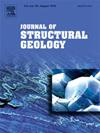砂岩储层成岩作用与断裂作用的相互作用:来自格罗宁根气田的推论
IF 2.9
2区 地球科学
Q2 GEOSCIENCES, MULTIDISCIPLINARY
引用次数: 0
摘要
通过对荷兰Groningen气田Rotliegend储层碎裂带和唯一的断层泥的微观结构和岩石学分析,研究了该储层断裂带的渐进成岩演化。研究表明,自生石英、铁白云石、菱铁矿和硬石膏在空间上与断层的存在密切相关。复合石英在寄主岩石中的不均匀分布表明,储层中石英很容易获得,但石英的沉淀受到包裹层和缓慢生长的自面体面的抑制。石英胶结作用优先集中在碎裂带中,在碎裂带中,新的断裂面提供了有利的成核位置。硬石膏和菱铁矿胶结物集中在碎裂带的膨胀裂缝中或与其相邻的寄主岩中。根据它们与膨胀裂缝的关系以及硫酸盐和还原性流体所需的来源,我们认为它们是在成岩历史的晚期由外部的断层相关流体引入的。碎裂带中石英的优先胶结作用表明,格罗宁根断裂多经历胶结强化,而在BIR-01井富粘土断裂核中,这一过程受到抑制,表明断裂再活化最有可能发生在弱断裂核中。本文章由计算机程序翻译,如有差异,请以英文原文为准。

Interaction between diagenesis and faulting in sandstone reservoirs: Inferences from the Groningen gas field
We investigated the progressive diagenetic evolution of fault zones in the Rotliegend reservoir of the Groningen gas field (NE Netherlands) through microstructural and petrological analysis of cataclastic bands and the only retrieved fault gouge from the reservoir. Our observations show that authigenic quartz, ferroan dolomite, siderite and anhydrite are spatially associated with the presence of faults in the reservoir.
The uneven distribution of syntaxial quartz overgrowths in the host rock suggests that silica was readily available in the reservoir, but that quartz precipitation was inhibited by coatings and slow-growing euhedral faces. Quartz cementation was preferentially concentrated in cataclastic bands, where fresh fracture surfaces provided favourable nucleation sites.
Anhydrite and siderite cements are concentrated in dilatant fractures in cataclastic bands or in the host rock adjacent to it. Based on their association with dilatant fractures and the required sources for sulphates and reducing fluids, respectively, we interpret that they were introduced by extrinsic, fault associated fluids, during a late stage of the diagenetic history.
The preferential quartz cementation in cataclastic zones suggests that many Groningen faults experienced cementation-related strengthening, while this process was inhibited in the clay-rich fault cores as observed in the BIR-01 well, implying that fault reactivation is most likely to occur within the weak fault core.
求助全文
通过发布文献求助,成功后即可免费获取论文全文。
去求助
来源期刊

Journal of Structural Geology
地学-地球科学综合
CiteScore
6.00
自引率
19.40%
发文量
192
审稿时长
15.7 weeks
期刊介绍:
The Journal of Structural Geology publishes process-oriented investigations about structural geology using appropriate combinations of analog and digital field data, seismic reflection data, satellite-derived data, geometric analysis, kinematic analysis, laboratory experiments, computer visualizations, and analogue or numerical modelling on all scales. Contributions are encouraged to draw perspectives from rheology, rock mechanics, geophysics,metamorphism, sedimentology, petroleum geology, economic geology, geodynamics, planetary geology, tectonics and neotectonics to provide a more powerful understanding of deformation processes and systems. Given the visual nature of the discipline, supplementary materials that portray the data and analysis in 3-D or quasi 3-D manners, including the use of videos, and/or graphical abstracts can significantly strengthen the impact of contributions.
 求助内容:
求助内容: 应助结果提醒方式:
应助结果提醒方式:


